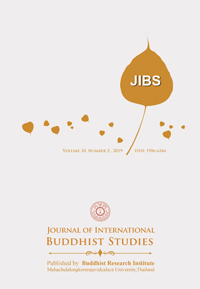The Concept of Chinese Chan: Perspectives from Tóng Méng Zhǐ Guān(童蒙止观)
Keywords:
Master Zhìyǐ, Chinese Chan, Śamatha and Vipaśyanā MeditationAbstract
To what extent can the practice of Buddhist śamatha and vipaśyanā meditation be seen as “Chinese Chan”? This article takes the initiative to analyze a short yet classical Chinese Buddhist text, the Foundations for Developing Buddhist Tranquility (Śamatha) and Insight (Vipaśyanā) Meditation童蒙止观. It examines the Foundations’ relationship with the elements of ancient Chinese culture and tradition that impact the practice of śamatha and vipaśyanā meditation. By revealing the fact that the meditation practice presented by the Foundations adopts substantial elements from ancient Chinese culture and tradition, this article suggests that the concept of “Chinese Chan” is significant for understanding the practice of śamatha and vipaśyanā meditation insofar as Chinese context is concerned.
References
Anālayo. Satipaţţhāna: The Direct Path to Realization. Cambridge: Windhorse Publications, 2003.
Brahmavamso, Ajahn. The Basic Method of Meditation. New York: The Buddhist Association of the United States, 2003.
Griffith, Paul. “Concentration or Insight: The Problematic of Theravāda Buddhist Meditation Theory,” in the Journal of the American Academy of Religion, 49.4, (December 1981): 605-624.
Jùn, Cháng常峻, Zhōngguó shēngxiāo wénhuà 中国生肖文化. China: Shanghai Lexicographical Publishing House, 2001.
Junjirō, Takakusu & Kaikyoku, Watanabe., eds. Taishō shinshū dai zōkyō 大正新修大藏经. Tokyo: Taishō Issaikyō Kankōkai, 1924–1932 [–1935].
King, Winston L. “Sacramental Aspects of Theravāda Buddhist Medita tion.” in Numen, 36, Fasc.,1989.
Swearer, Donald K. “Control and Freedom: The Structure of Buddhist Meditation in the Pāli Suttas.” in Philosophy East and West, 23. 4, 1973.
Soothill, William Edward., & Hodous, Lewis., ed. A Dictionary of Chinese Buddhist Terms. London: Kegan Paul, Trench, Trubenr and Co., 1977.
Táo, Hóngjǐng 陶弘景. Records for Nourishing the Body and Ex- tending the Lifespan 养性延命录. https://ctext.org/wiki. pl?if=gb&chapter=640421
Woodward, F. L. trans. The Book of the Gradual Sayings (Anguttara-Ni kaya) or More-Numbered Suttas. London: Luzac & Company Ltd, 1962, Vol II.
Zhū, Fěi 朱斐, ed. Inner Canon of the Yellow Emperor黄帝内经. Taipei: New Vision Publisher Inc., 2018.







